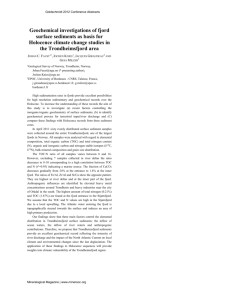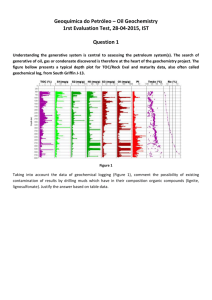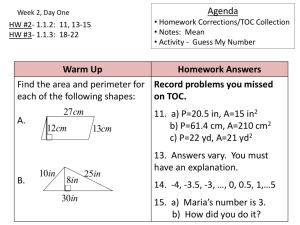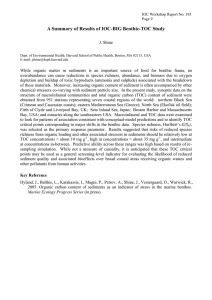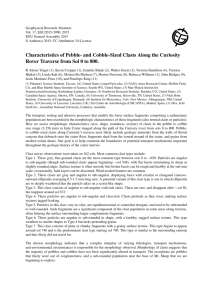In the Tyrrhenian Sea the investigations focused on studies of... volcano-tectonic processes related to three biggest submarine volcanos: the Marsili,...
advertisement
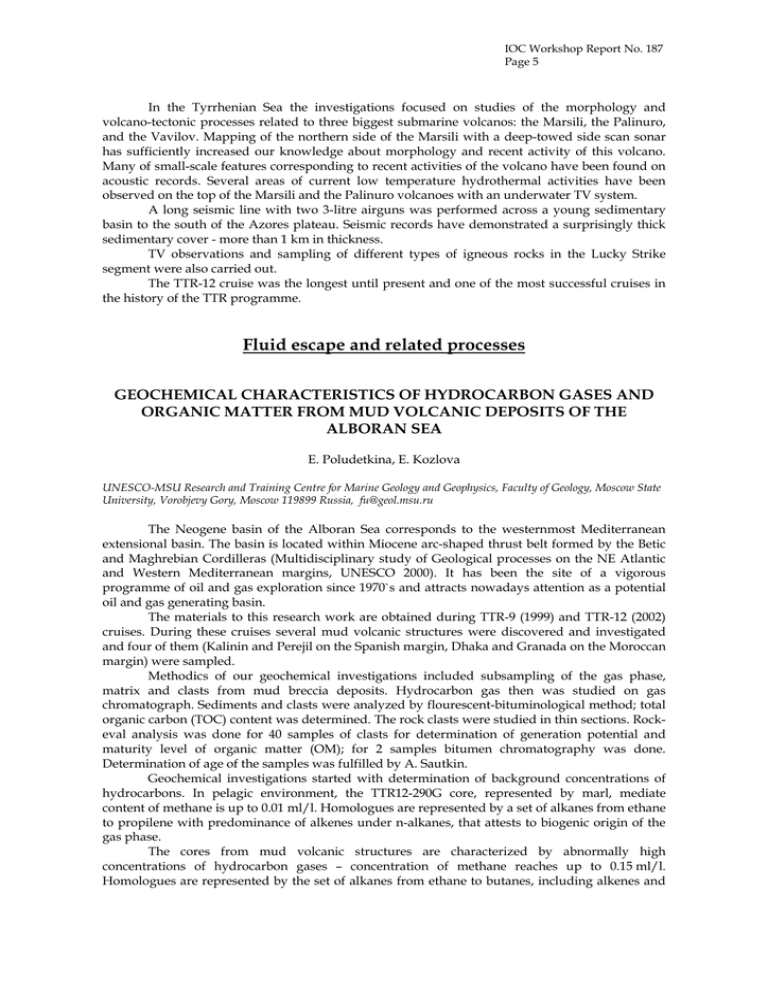
IOC Workshop Report No. 187 Page 5 In the Tyrrhenian Sea the investigations focused on studies of the morphology and volcano-tectonic processes related to three biggest submarine volcanos: the Marsili, the Palinuro, and the Vavilov. Mapping of the northern side of the Marsili with a deep-towed side scan sonar has sufficiently increased our knowledge about morphology and recent activity of this volcano. Many of small-scale features corresponding to recent activities of the volcano have been found on acoustic records. Several areas of current low temperature hydrothermal activities have been observed on the top of the Marsili and the Palinuro volcanoes with an underwater TV system. A long seismic line with two 3-litre airguns was performed across a young sedimentary basin to the south of the Azores plateau. Seismic records have demonstrated a surprisingly thick sedimentary cover - more than 1 km in thickness. TV observations and sampling of different types of igneous rocks in the Lucky Strike segment were also carried out. The TTR-12 cruise was the longest until present and one of the most successful cruises in the history of the TTR programme. Fluid escape and related processes GEOCHEMICAL CHARACTERISTICS OF HYDROCARBON GASES AND ORGANIC MATTER FROM MUD VOLCANIC DEPOSITS OF THE ALBORAN SEA E. Poludetkina, E. Kozlova UNESCO-MSU Research and Training Centre for Marine Geology and Geophysics, Faculty of Geology, Moscow State University, Vorobjevy Gory, Moscow 119899 Russia, fu@geol.msu.ru The Neogene basin of the Alboran Sea corresponds to the westernmost Mediterranean extensional basin. The basin is located within Miocene arc-shaped thrust belt formed by the Betic and Maghrebian Cordilleras (Multidisciplinary study of Geological processes on the NE Atlantic and Western Mediterranean margins, UNESCO 2000). It has been the site of a vigorous programme of oil and gas exploration since 1970`s and attracts nowadays attention as a potential oil and gas generating basin. The materials to this research work are obtained during TTR-9 (1999) and TTR-12 (2002) cruises. During these cruises several mud volcanic structures were discovered and investigated and four of them (Kalinin and Perejil on the Spanish margin, Dhaka and Granada on the Moroccan margin) were sampled. Methodics of our geochemical investigations included subsampling of the gas phase, matrix and clasts from mud breccia deposits. Hydrocarbon gas then was studied on gas chromatograph. Sediments and clasts were analyzed by flourescent-bituminological method; total organic carbon (TOC) content was determined. The rock clasts were studied in thin sections. Rockeval analysis was done for 40 samples of clasts for determination of generation potential and maturity level of organic matter (OM); for 2 samples bitumen chromatography was done. Determination of age of the samples was fulfilled by A. Sautkin. Geochemical investigations started with determination of background concentrations of hydrocarbons. In pelagic environment, the TTR12-290G core, represented by marl, mediate content of methane is up to 0.01 ml/l. Homologues are represented by a set of alkanes from ethane to propilene with predominance of alkenes under n-alkanes, that attests to biogenic origin of the gas phase. The cores from mud volcanic structures are characterized by abnormally high concentrations of hydrocarbon gases – concentration of methane reaches up to 0.15 ml/l. Homologues are represented by the set of alkanes from ethane to butanes, including alkenes and IOC Workshop Report No. 187 Page 6 iso-alkanes – such heavy homologues are not characteristic for biogenic gas. Alkanes prevail under alkenes, distribution of TOC content is not correlating with the distribution of hydrocarbons. All these facts imply an input of thermogenic gas. Comparing gas concentrations with concentrations of hydrocarbons from the other regions of mud volcanism activity (the Black Sea, the Gulf of Cadiz), we find out that the Alboran basin is a relatively inactive region with a small input of hydrocarbon gases from the inner parts of the sedimentary sequence. HI 700 Type 1 500 Type 2 300 100 Type 3 On the basis of geochemical analyses we can assume what the strata can generate hydrocarbons and Immaturation Oil window Gas window thus can be considered as “potential - samples oil- and gas-generating sediments”. The geochemical investigations of rock clasts were carried out on Van-Krevelen diagram (HI - Tmax) showing types of kerogen and maturity level (materials of E. Kozlova, TTR-9) samples from mud volcanic deposits of the Granada mud volcano (sites TTR9-258G, TTR9-259G, TTR12-288 GR). TOC content in most of the clasts does not exceed 0.3%, but there are unique clasts rich in OM (TOC=0.68-7.37%). These clasts refer to N12, Pg22, Pg12 and K2 age. Most organic rich clasts are N22 rocks (7.37%) and K2 siltstones (2.94%). The Van-Krevelen diagram shows that most of the samples contain III (hymic) type of OM, that can generate hydrocarbon gas. Several samples (mostly of K2 age) contain II (mixed) type of OM. Two samples are close to the zone of the -Low oil-potential (Corg= 0,21%, HI= 133, S1+ S2= 0,29) oil window – Upper Cretaceous clay and - very high oil-potential (TOC= 7,37%, S1+ S2= 43,5, HI= 622) Middle Eocene clay. In common it can be seen -Low oil-potential (Corg= 0,68%, that samples of one age S1+ S2= 0,53, HI= 35) have absolutely different level of maturity. Geochemical -Mediate oil-potential (Corg= o,68%,S1+ S2= 1,48, HI= 186, ) analyses showed that the sediments of the -Low oil-potential (Corg= 0,1%, HI= 20) Alboran Sea include middle and high oilpotential strata, that -Low-mediate oil-potential (HI< 160) generate or can generate hydrocarbons. These -High oil-potential (Corg= 2,94%, HI= 577, S1+ S2= 21,5) are: N12 sediments (TOC=7.37%; S2=43.5 hydrocarbons, mg/ – rock, g factual rock potential; Geochemical characteristics of sedimentary units (K2-N) HI=622 hydrocarbons, mg/TOC, (materials of E. Kozlova, TTR-9) 400 420 440 460 Tmax, 480 IOC Workshop Report No. 187 Page 7 2 hydrocarbons, mg/ g - very high oil potential); Pg1 carbonates (TOC=0.68%; S2=1,27 rock, g; HI=186 hydrocarbons, mg/ hydrocarbons, mg/ TOC, g – mediate oil potential); K2 siltstones (TOC=2.94%; S2=17 rock, g; HI=577 hydrocarbons, mg/TOC, g – high oil potential). Thus among the studied sediments we can divide middle- and high oil-potential strata that can generate hydrocarbons nowadays or in the future. So, the Alboran Sea can be considered as a potential oil-bearing basin. NATURE AND ORIGIN OF MUD VOLCANO SEDIMENTS OF THE GULF OF CADIZ (TTR-12 CRUISE) M. Rachidi1, N. Hamoumi1, M. Labraimi1, M. Ivanov2, J.-P. Henriet 3, E. M. Lotfi4, M. Benbouida1 1 Laboratory of Sedimentology and Marine Geology, Mohammed V- Agdal University, Rabat, Morocco of Geology, Moscow State University, Russia 3 RCMG, Ghent University , Belgium 4 High School of Technical Teatching (ENSET), Rabat, Morocco 2 Faculty Sediments sampled by dredging, TV Grab and gravity core from mud volcanoes: Idrissi (TTR12-AT411G, TTR12-AT412D), TTR (TTR12-AT414G), Jesus Baraza (TTR12-AT391Gr), Capitan Arutjunov, (TTR12-AT397G, TTR12-AT398G, TTR12-AT399Gr, TTR12-AT400G), Fuiza, (TTR12AT403G), Gemini (TTR12-AT404G, TTR12-AT405G), Renard ridge (TTR12-AT406Gr, TTR12AT407Gr) and Mercator (TTR12-AT408G, TTR12-AT409D, TTR12-AT410D), during the TTR-12 cruise (July 2002) in the Gulf of Cadiz were the subject of a sedimentological study in order to specify their mineralogical composition and to reconstitute their parent rocks. These sediments consist of mud breccia composed of dominated poorly sorted matrix and sparce clasts of various sizes (mm to dm) and shapes (rounded to angular). Petrological study under polarising microscope of the clasts allowed to recognize 10 main groups such as: PF1 : porphyritic basalt composed of pyroxene and plagioclase phenocrysts within glassy groundmass that may exhibit alteration in chlorite, calcite, hematite and pyrite; PF2 : finely porphiritic basalt composed of concentrically zoned amygdales that are often filed of calcite and quartz, sericitised laths of plagioclases within glassy groundmass sometimes altered in chlorite, pyrite and hematite; PF3 : calcareous sandstones composed of poorly sorted quartz of various shapes (rounded to angular), tourmaline, glauconite and bioclasts within a cement of microsparite; PF4: silty biomicrite composed of lamina of micritic matrix with bioclasts and stromatolithe filaments and sparse detrital minerals: angular quartz, heavy minerals (tourmaline, zircon), micas (biotite, chlorite, muscovite); PF5: sandy biomicrite composed of micritic or microsparitic cement, bioclasts (Echinoderm, and Foraminifera), quartz, rocks fragments (volcanic, metamorphic) and altered micas; PF6: sandy allochemic limestone exhibiting bioclasts (Foraminifera, Echinoderm, Gastropod, algaes) and detrital minerals: quartz, mica, chlorite, biotite, muscovite), heavy minerals (zircon, tourmaline) and pyrite within a cement of sparite and microsparite; PF7: sparitic limestones; PF8: biosparite exhibiting Echinoderm and Gastropod within microsparitic cement; PF9: polymictic clast composed of rock fragments (carbonate, siltstone, mudstones) and carbonate crystals coated by marl and clay; PF10: polimictic clast: clay aggregates and soft pebbles coated by mixtures of marls and clays often affected by soft sediment features. The clasts corresponding to groups (PF1 to PF8) are realised from the disintegration of old deposit known on onshore geological formations. The volcanic rocks (PF1, PF2) are related to Triassic basalt, the mixed siliciclastic/carbonate group PF3 is originated from Oligo - Miocene
